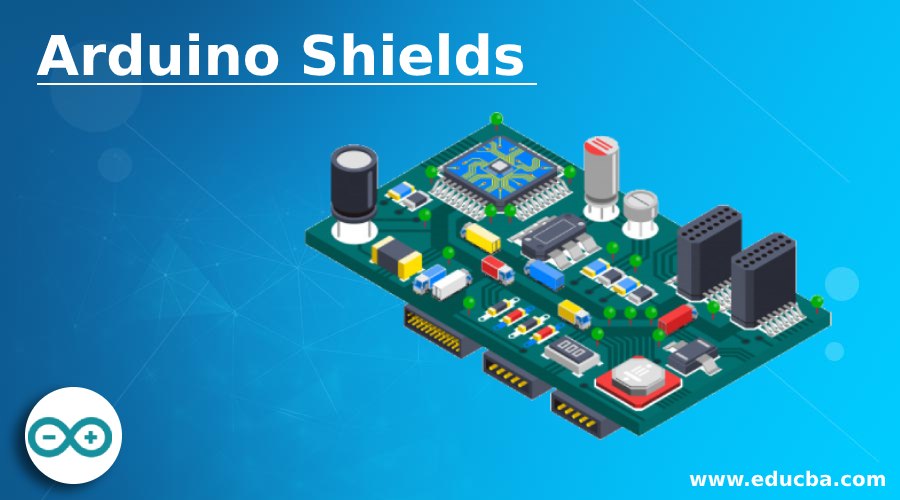Updated May 31, 2023

Introduction to Arduino Shields
Arduino shields are the boards attached to the board of Arduino to improve its functionality. Various shields, such as motor shields, contact shields, etc., are essential to various tasks. The shield is known as the hardware tool to increase the capabilities of projects that can be mounted over the board. It also facilitates our work. The board is connected to the Internet using Ethernet Shielding, for instance. The shields are identical to Arduino boards in a pin position. The connecting cable can also attach the modules and sensors to the shields.
How Useful Are the Arduino Shields?
Their respective modules can replace most shields and corresponding circuits/wires. There are various advantages of shields which are as follows:
- You don’t have to think about the loop. Typically the shield contains all components that you need.
- You need to place shields across the Arduino pins – they are less susceptible to errors than connecting the separated pieces.
- The shield can be removed from the Arduino quickly and kept when you like, without concerns about doing the circuit and canceling it again.
- Shields quickly add new functionality to the Arduino, which would be challenging to build otherwise.
Top Useful Arduino Shields
You can easily connect your Arduino to the Internet with an Ethernet shield. The Arduino acts as a client or a server with this shield. You have to install the shield on Arduino and connect it via an Ethernet cable to a network. The Ethernet shield also contains an SD card slot to store network data. The shield can access the Arduino pins, meaning that extra hardware or another shield can still be attached on top. The Arduino Ethernet Library supports the Ethernet shield.
1. L293D Motor Drive Shield
The motor shield offers a simple way for Arduino to power engines, so the circuitry must not be built. You have to attach the motors to the sockets. It comes with 3 processors, 4 DC engines or 2 phase motors, or 2 servo engines. It has 3 driver processors. It also has a connector for attaching an external motor power supply.
2. Data Logging Shield
The data logging shield is handy for logging data, as the name implies. She has an SD card slot – she uses an SD card for data storage. It has a built-in RTC with a battery carrier that keeps track of time, even though the Arduino system does not power it. It also has a prototyping area for welding connections, sensors, etc. This is the ideal security for creating a portable data logger.
3. Proto Shield
The prototype shield is a prototype shield but doesn’t do anything alone. But it is beneficial to layout your projects without space because it is supplied with a mini breadboard that perfectly fits on top of the shield. In addition, to produce a nice, permanent circuit, you can solder your system to the prototyping area.
4. Adafruit RGB LCD Shield
This Adafruit shield comes with a five-button and RGB LCD. The main benefit of the defense is that it uses only two I2C Arduino pins over other LCD shields or even other LCD screens. Many sensors can be attached to these pins because they share the I2C bus. This means that all the pins for connecting other components are still open.
5. Arducam Mini Module Camera Shield
With 5 megapixels, this shield uses SPI communication to interface with the Arduino. This is a simple way to add a webcam to your projects in Arduino. It can capture 5MP JPEG pictures and capture tiny video clips. This system also supports other blackboards such as Raspberry Pi, ESP8266, and Beaglebone.
6. Bluetooth Shield
You can use the Bluetooth shield as a transparent serial communication wireless board. It has a Bluetooth serial board. D0 and D1 are Bluetooth hardware ports that connect to the Arduino board’s two serial ports (from D0 to D7).
7. Arduino WiFi Shield
The shield protects a wide range and sends the new secure onboard antenna for powerful signals.RN171 supports the networking protocols UDP, TCP, FTP, and HTTP, which fulfills needs for many network projects such as Wireless and Internet Stuff (IoT), Smart Home Networks, robots, and weather stations.
8. RS232 Arduino Shield
RS232 Shield is an industrial equipment communications standard port. This module is based on MAX232, a dual driver/receiver that contains a capacitive voltage generator to provide a single 5-V supply to the TIA / EIA-232-F voltage stage. The shield incorporates DB9 (female) connectors with different RS232 devices. In addition, communications and commissioning are supported by RS232 headers. It offers the welding areas to use extra space for prototyping fully. It is convenient.
Conclusion
In this article, we have seen what Arduino shields are, their uses, and various Arduino shields tools.
Recommended Articles
This is a guide to Arduino Shields. Here we discuss an introduction to Arduino Shields, how useful it is, and the top 8 useful shields in detail. You can also go through our other related articles to learn more –

